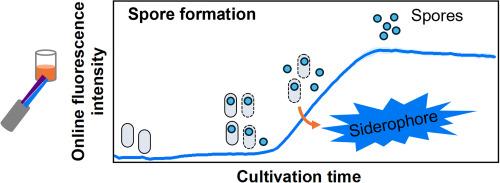在线光谱技术在复杂培养基培养芽孢杆菌孢子检测中的应用
IF 1.9
4区 生物学
Q4 BIOCHEMICAL RESEARCH METHODS
引用次数: 0
摘要
芽孢杆菌孢子在一系列生物技术应用中很重要。实时孢子检测方法有利于有效地表征和优化孢子生产过程。在这项研究中,提出了一种利用光谱技术在线监测芽孢杆菌孢子形成的定性高通量方法。在BioLector装置中培养枯草芽孢杆菌PY79菌株,观察到激发波长为390 nm,发射波长为460 nm的特异性荧光增加,这与母细胞在复杂培养基中释放孢子有关。因此,通过实时测量该荧光波长组合,可以在高通量实验中监测孢子的释放。此外,该方法对芽孢杆菌菌株的适用性,而不是枯草芽孢杆菌,突出了其在工业过程中的广泛相关性。这种方法有可能比传统方法(如电镀技术)更可靠、更有效地检测孢子。最后,铁离子猝灭实验表明,铁基团引起了特征荧光信号,证明了该方法在铁基团研究领域的有效性。本文章由计算机程序翻译,如有差异,请以英文原文为准。

Application of online spectroscopic techniques for detection of Bacillus spores in cultivations with complex medium
Bacillus spores are important in a range of biotechnological applications. Real-time spore detection methods are advantageous for effectively characterizing and optimizing the spore production processes. In this study, a qualitative high-throughput method for online monitoring of Bacillus spore formation using spectroscopic techniques is presented. An increase in specific fluorescence at an excitation wavelength of 390 nm and an emission wavelength of 460 nm was observed during the cultivation of the spore-forming Bacillus subtilis PY79 strain in a BioLector device, which correlated with the release of spores from the mother cells in a complex medium. Therefore, spore release can be monitored in high-throughput experiments by real-time measurement of this fluorescence wavelength combination. Additionally, the applicability of this method to Bacillus strains other than B. subtilis highlights its broad relevance in industrial processes. This method has the potential to detect spores more reliably and efficiently than conventional methods such as plating techniques. Finally, quenching experiments with iron ions indicated that a siderophore causes the characteristic fluorescence signal, demonstrating the usefulness of this method also in research areas focused on siderophores.
求助全文
通过发布文献求助,成功后即可免费获取论文全文。
去求助
来源期刊

Journal of microbiological methods
生物-生化研究方法
CiteScore
4.30
自引率
4.50%
发文量
151
审稿时长
29 days
期刊介绍:
The Journal of Microbiological Methods publishes scholarly and original articles, notes and review articles. These articles must include novel and/or state-of-the-art methods, or significant improvements to existing methods. Novel and innovative applications of current methods that are validated and useful will also be published. JMM strives for scholarship, innovation and excellence. This demands scientific rigour, the best available methods and technologies, correctly replicated experiments/tests, the inclusion of proper controls, calibrations, and the correct statistical analysis. The presentation of the data must support the interpretation of the method/approach.
All aspects of microbiology are covered, except virology. These include agricultural microbiology, applied and environmental microbiology, bioassays, bioinformatics, biotechnology, biochemical microbiology, clinical microbiology, diagnostics, food monitoring and quality control microbiology, microbial genetics and genomics, geomicrobiology, microbiome methods regardless of habitat, high through-put sequencing methods and analysis, microbial pathogenesis and host responses, metabolomics, metagenomics, metaproteomics, microbial ecology and diversity, microbial physiology, microbial ultra-structure, microscopic and imaging methods, molecular microbiology, mycology, novel mathematical microbiology and modelling, parasitology, plant-microbe interactions, protein markers/profiles, proteomics, pyrosequencing, public health microbiology, radioisotopes applied to microbiology, robotics applied to microbiological methods,rumen microbiology, microbiological methods for space missions and extreme environments, sampling methods and samplers, soil and sediment microbiology, transcriptomics, veterinary microbiology, sero-diagnostics and typing/identification.
 求助内容:
求助内容: 应助结果提醒方式:
应助结果提醒方式:


